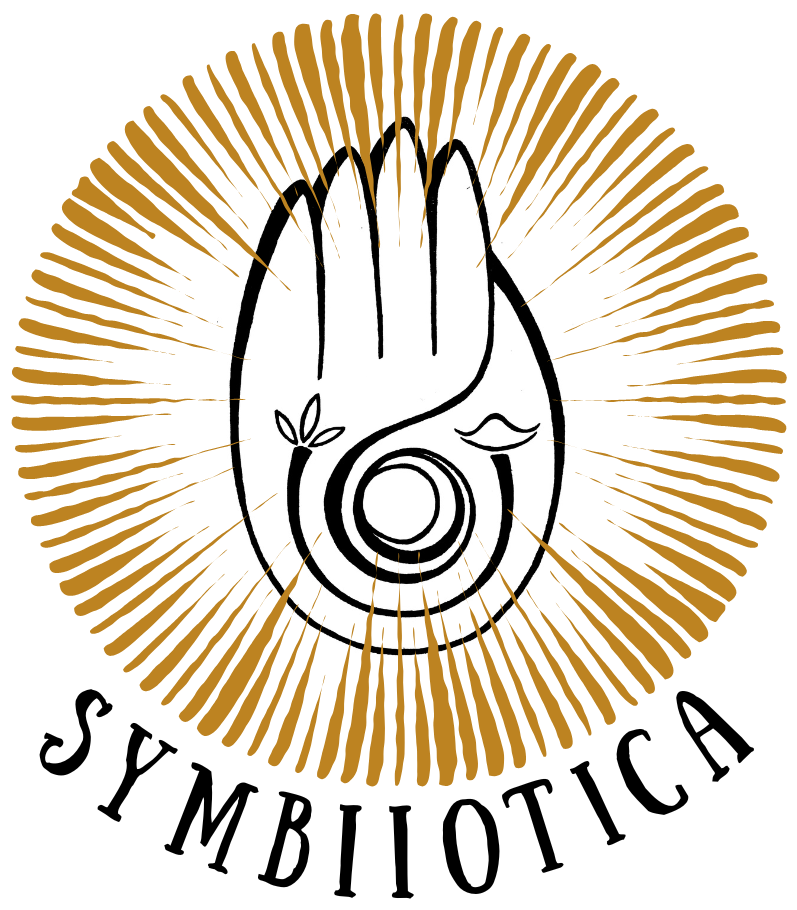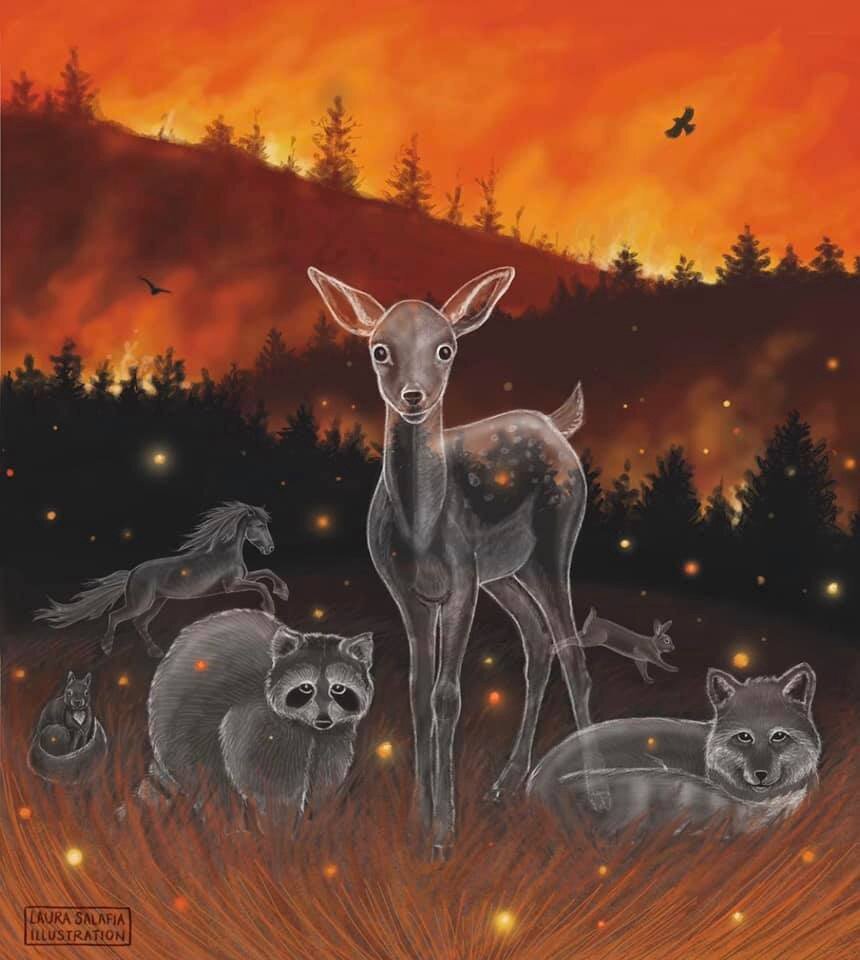Burning For Answers
Written in the heat of the 2020 Fire Season on Southern Pomo Land
Powerful art by Laura Salafia
The land, hot with fire.
The sun, reddened from a smoke filled sky.
Casting prayers of protection, we hold on for some semblance of certainty.
Holding the belief that it cant come here… no it cant… no it wont… be us.
Many of us holding the deep questions of how this came to be
and we're burning for answers.
When the masses point to climate change as the cause of the increasing catastrophic wildfires in California, I say yes, AND, let’s look a little deeper.
With wide eyes and a tender heart, I take a breath of deep acknowledgement that a dynamic mosaic of fires are dancing throughout the West of continental US as I write. Here, I attune my focus on the lands we call California; specifically occupied Southern Pomo/Coast Miwok territory, as that is the grounds of which I live with and write from. However, much of what I discuss here can be applied to analogous fire-prone ecologies of comparable latitudes.
The post-industrial anthropogenic alteration of Calfiornia’s ecosystems, increase in desertification feedback loops, build up of fuel load from fire suppression and subsequent catastrophic wildfires (now being termed ‘megafires’) are separate but related phenomena that I notice more and more people tend to lump together and call ‘climate change’. It is a comfortable way of addressing these complexities. Yes, these are all be inflamed (literally) by rapidly changing climate regimes, however they are systemically complex and involve a multiplicity of variables, all which have been playing out for the past few centuries. Climate alteration pushes these tipping points over the edge, blowing bioregional gaskets and attributing to the overshoot of planetary boundaries.
Other contributing factors to the rise in catastrophic mega fires in the west include but are not limited to (List adopted and added upon from Stephan Gordon):
The extirpation of beavers and eradication of the golden grizzly (the California subspecies of grizzly which now only lives as a symbol on California’s state flag, a pretty appalling irony) and other keystone species & ecosystem engineers.
Colonization induced genocide and attempted irradication of Indigenous peoples and their unimaginably vast, deeply rooted and invaluable ecological knowledge, cultural traditions, and ways of life which were intimately tied to regenerative land tending and management practices.
Fire suppression (directly linked to the oppression and attempted eradication of Indigenous peoples and their cultural practices i.e. controlled burning) and political propaganda (i.e. Smokey the Bear) which enforces the colonial ideology & psychological warfare of pyrophobia (fear of fire).
Too few cultural/controlled burns because the Forest Service and federal agencies still refuse to listen to Indigenous voices
The extirpation of native undulate grazers like massive herds of tule elk as well as their predators like mountain lion and bear, leading to destructive trophic cascades and the loss of countless ecological services.
Mismanagement of domesticated livestock leading to large-scale grassland degradation and loss of biodiversity
Introduction of invasive plant species including highly flammable species like eucalyptus.
Intentional draining of wetlands and damming of watersheds, decimating salmon spawning habitats and salmon populations whom provided essential nutrients to forest ecologies.
Destruction of soils through intensive industrial agriculture; monocroping, tillage and chemical inputs.
Clear cutting for lumber and interrupting the Biotic pump cycle, altering micro-climates, local hydrological cycles and hydrological cycles on a bioregional scale.
Clear cutting coastal forests and leveling older, more fire resistant forest ecosystems like Quercus (oak) and Sequoia (redwood) spp.
Replacing diverse forests with mono croppings of trees more prone to disease/pathogen infestation and transmission for lumber and profit.
A ‘hands-off, leave no trace’ attitude toward forest management and lack of ecological participation. Again, little to no prescribed burning or thinning of undergrowth with holistic grazing and/or other approaches to large-scale regenerative forestry management.
I share this here because many people are just not beginning to ask why, and I want to do my small part to try to tell at least a mere fraction of the story, of which none of us (besides Indigenous folks of this place, rocks, seas and trees themselves) know the true extent.
These contributing factors have permanently altered the hydrologic cycle in California, allowing for the amassing of fuel and ultimately, a huge alteration in ecosystem function cross-bioregionally. Simply attributing everything to “climate change” is, in my opinion, a dangerous generalization and a tactic of bypassing the grim story of what’s truly unfolded on these lands - a story that’s incredibly painful and challenging to sit with.
But unless we sit in the fire of the truth and realize how we got here, how can we possibly find a way to repair, to heal, to face the consequences of our impact head on and begin align our actions with our awareness?
Fire lives here. Fire lives on this land, as it has for thousands of years before this generation and as it will continue to do so far into the future. We cannot wish it away. We can try to fight it, to no avail. As we very well now know, if we wage war against fire, fire will win. All who choose to live on these lands must learn to dance with it, befriend it, co-exist with it, adapt with it, as the Indigenous peoples of this land have for thousands of years and continue to do to this day (https://www.culturalfire.org)
I greive from the marrow of my bones for the human and more than human communities of modernity who suffer from the repercussions of this human-made, colonial imbalance, And, I also hold faith that there is opportunity for unimaginable healing - a literal phoenix rising from the ashes. For underneath it all, life creates the conditions conducive to life.
But how do we live in mutualistic, collaborative symbiosis with such a fierce, powerful force when we live within societal structures and cultural paradigms that reinforce colonial notions which demonize, scrutinize and subsequently repress fire on the land?
I do not have the answers, but underneath the smoke of delusion, I feel hope.
Due to the complex, systemic nature of these issues, there isn’t going to be a magical silver bullet solution that rises out of the ashes. There will be no single umbrella approach to social, cultural, ecological regeneration that re-directs the course of climate augmentation, continued racial/cultural oppression, and overshoot of planetary boundaries. Rather, I see change coming from collectives of many small, local unifications and their unique processes of remembering our inherent participatory nature and inextricable interdependence with the lands, beings, and systems that give us life.
Let’s talk about how, and then, go do it.
Our human and non human families are waiting for us.

